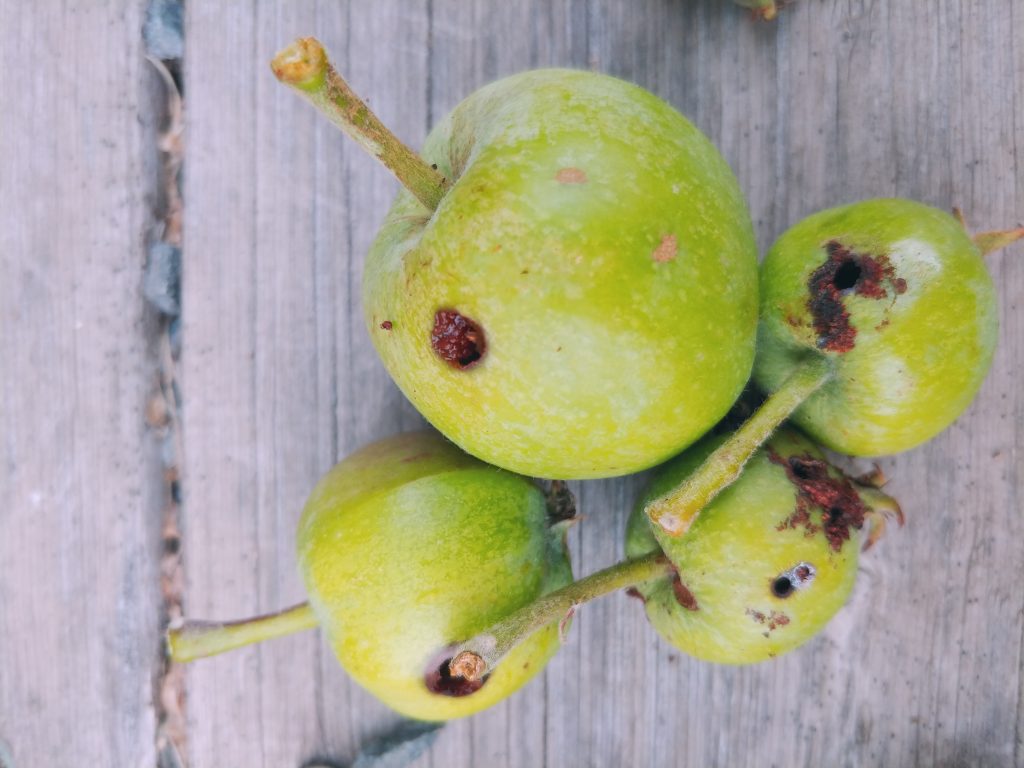
Codling moth
What is codling moth? And how can I get rid of it?
Fruit trees are amazing and we love our Urban Orchard for the abundant harvest it provides each year. However, we’re not the only ones who love these trees and their fruits–pests come out of the woodwork (literally) and wreak havoc on the harvest. All pests are annoying, but codling moth can be particularly tricky for the trees in our own backyards.
The most notorious pest in the Pacific Northwest, codling moths are a major pain for fruit tree owners in Victoria, BC. These pests love to prey on apples and pears, making our Urban Orchard a regular codling moth buffet. Because larvae don’t feed on leaves, these pests can have a particularly devastating effect on your fruit.
According to the BC Fruit Tree Production Guide, mature larvae overwinter in protected sites on your property–under loose bark, in woodpiles, in soil, or even in bins and on ladders near your trees. The larvae pupate in the spring and adults emerge in early May, continuing to emerge until late June. From here, females will lay their eggs on leaves or near the fruit. These eggs are so small and lightly coloured that they are nearly impossible to spot. When the eggs hatch, larvae motor across the fruit’s surface and bore a hole deep into the centre where they can consume the still-soft seeds. Sometimes, you might not even notice your fruit have been affected until you cut into one and see the interior damage. Every fruit-eaters biggest nightmare!
In our temperate climate, we experience not one but two generations of codling moths each season. The second hatch occurs in late July-early August and can cause significant damage to ripening apples and pears.
How can I prevent codling moth?
We recommend a diverse approach to tackling the issue and believe that a preventative management/insect control combo can reduce their impact on your yard.
Remove leaves & fallen fruit
The best place to start with pest management is to keep your yard clear. As mentioned, codling moth larvae like to overwinter in leaf piles and compost heaps.
For those dedicated to backyard composting, you can ensure any hibernating larvae are taken care of with high heat composting systems, but most backyard compost piles will have cold spots where pupae still survive.
Fallen fruit can create the perfect environment for codling moths to hibernate. Backyard compost systems won’t break down whole fruits (like fallen apples) and larvae can climb out of the fruit, crawl over to cold spots, and enter the pupal stage of development.
Removal from property is key to the success of this approach and it’s also important to talk to your neighbours and make sure everyone is on board.
If you must compost, we suggest placing fallen fruit in a sealed black bag placed in the sun OR drown your fallen apples in water for an extended period of time.
Create insect barriers
Wrap a tree band or insect barrier around the trunk of your tree, tricking larvae into pupating on the barrier instead of loose leaves, bark, or other areas on your tree. There are options available for purchase, but crafty tree owners can also DIY something using cardboard. Wrap the cardboard around the trunk in late April, then remove, destroy, and replace with another set in early July in order to disrupt the cycle and stop subsequent generations of egg-laying adults.
Many folks also spread products like diatomaceous earth around the base of the trees. This barrier works by adhering to the exoskeleton of larvae, dehydrating and eventually killing them before they can crawl up and infest the tree. (While this can work on codling moths, we also think that this method is most effective on a different pest, winter moth, because the females are flightless).
Use this sparingly: diatomaceous earth is indiscriminate and will kill everything.
Refined kaolin clay can be applied to the leaves and fruit. It acts as an irritant for adults laying eggs and also as a plockade for larvae trying to enter the fruit.
Pheromone traps
Use the pheromones of the pest against itself! By hanging traps containing the moth’s female pheromones, you can attract and catch males. In order for these traps to be fully effective, you need to hang traps all around your yard. This confuses the males and makes it difficult to find the females. Hang these traps around bloom time.
You can also combine the pheromone trap and insect barrier methods using barriers that contain pheromones.
Spray
Spraying is a tried and true pest control method. If other approaches fail, you can turn to BTK, and granulosis virus sprays. With sprays, timing is everything–you need to be aware of blossom and leafing stages to be effective. Pheromone traps can help you know when adults are emerging and mating. For codling moth, you should spray during first leaf cover in spring and periodically throughout the summer.
While sprays are an effective pest management tool, we suggest using them sparingly in your backyard orchard. Codling moth is a difficult problem and sprays are best used as part of a more comprehensive management plan.
If you need help with backyard pests, let us know! Our tree care experts would be happy to share tips, tricks, and knowledge to keep your backyard pest-free.